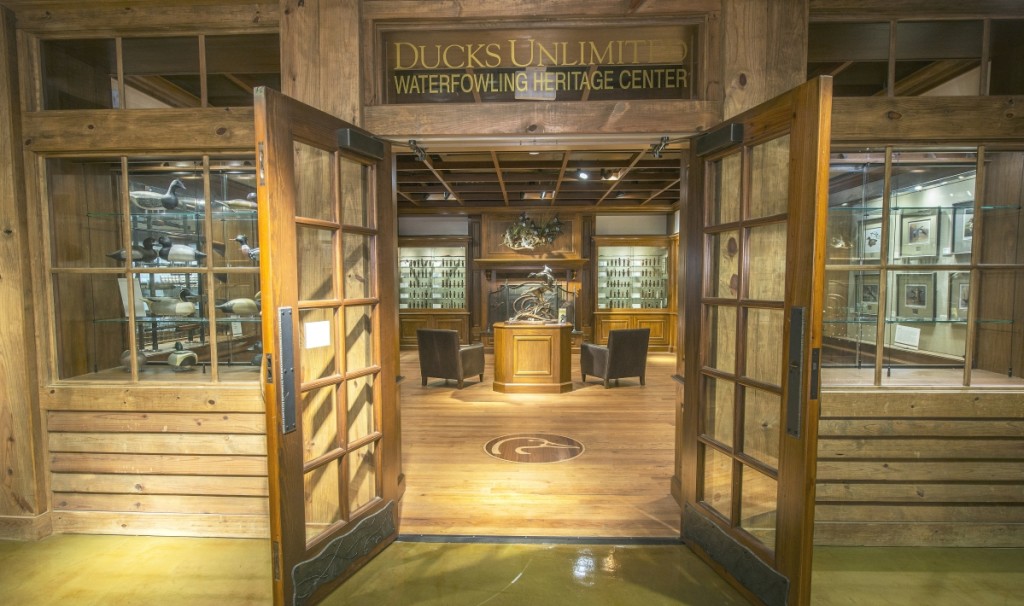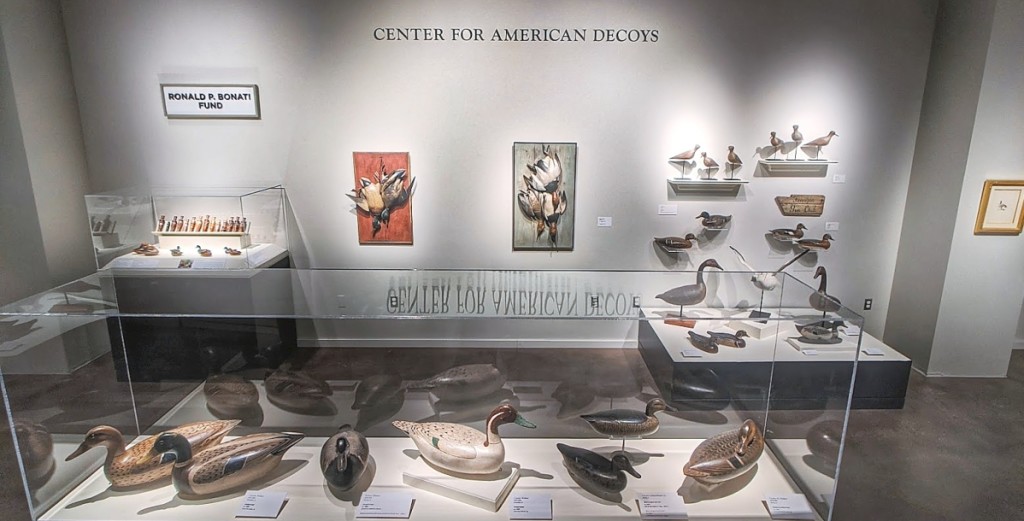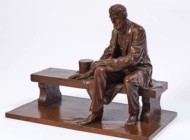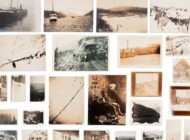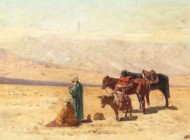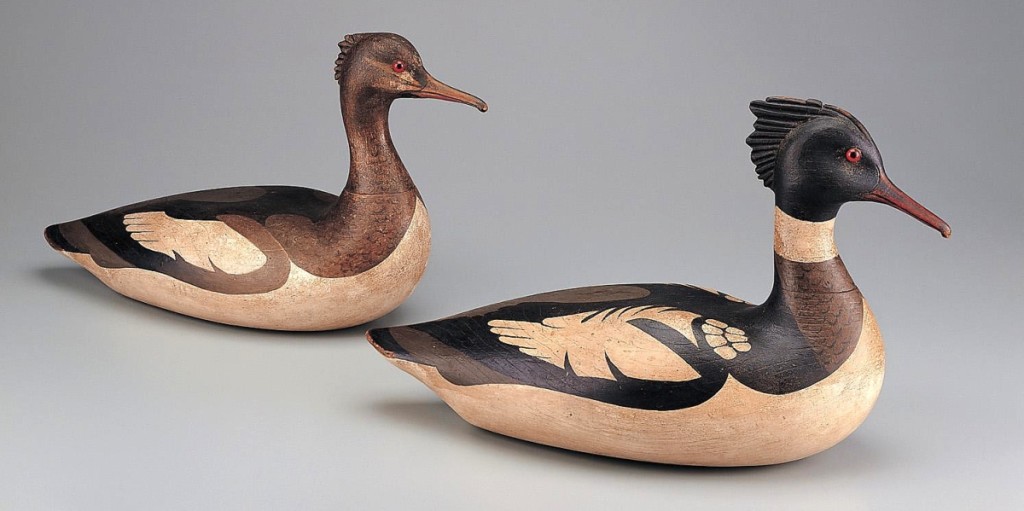
From the collection of the American Folk Art Museum, Lothrop T. Holmes (1824-1899), red-breasted merganser drake (foreground); red-breasted merganser hen (background), Kingston, Mass., 1860-70. Paint on wood with glass eyes, 9½ by 16 by 6 inches. Gift of Adele Earnest, 1994.
By Rick Russack, Contributing Editor
EAST COAST, UNITED STATES – Not only have sales of decoys at auction been strong this year, institutional interest is expanding.
There have been five major auctions by specialist decoy auction companies so far this year and they have grossed about $14,519,228. Included in these numbers aretwo sales with Copley Fine Arts, Hingham, Mass.; one sale with Decoys Unlimited, Barnstable, Mass.; and two more with Guyette & Deeter, St Michaels, Md. These numbers reflect only decoys and related carvings, such as miniatures and decoratives, and do not include other items, such as sporting paintings, that might have been sold along with decoys. Guyette & Deeter also conducts weekly online decoy sales, which so far this year would add another $1 million to the total, but that number is not included above. Unreported private sales push the market cap much higher.
Copley’s winter sale included 313 decoy lots, grossing $3,594,900. The firm’s summer sale included 380 decoy lots, grossing $3,123,160.
Guyette & Deeter’s April sale included about 450 decoy lots and grossed $3,884,190. The company’s August sale, which also included about 450 decoy lots, grossed $3,594,978.
The Decoys Unlimited sale of about 450 decoys grossed $322,000.
The numbers indicate strength at all levels of the market, with more than 20 “super-star” decoys each selling for more than $100,000 and hundreds selling under $1,000. There is truly something for everyone. Each auction company repeats, “We’re seeing numerous new collectors coming into the marketplace. And they’re staying with us and asking lots of questions.”
In addition, several institutions are becoming more involved with decoys and, with savvy use of social media, are reaching more people. Ducks Unlimited, Memphis, Tenn., is a well-known nonprofit organization dedicated to wetlands and waterfowl conservation. The group’s Heritage Center, a 500-square-foot gallery, permanently displays decoys and duck calls and curator Katie Burke said that they will soon be mounting an exhibit of Evans factory decoys. Talking about social media, she mentioned Instagram and the organization’s podcasts, which she co-hosts. “We have regular 30-minute podcasts devoted to our waterfowl heritage, and they’ve been downloaded more than 800,000 times,” said Burke. “Several have included interviews with decoy collectors and others involved in the decoy market. We also have short videos up that draw large numbers. We know that the demographics downloading the podcasts include many younger people and women.” For information on these podcasts, https://www.ducks.org/media/du-podcast.
The Peoria Riverfront Museum, Peoria, Ill., following a successful decoy exhibit two years ago, has created the Center for American Decoys, a large, new exhibition space devoted solely to decoys, especially those by Illinois River carvers, which include several of the acknowledged masters of the art form. They have published American Decoy: The Invention a 200-page, full-color book, illustrating decoys from a recent exhibition of the same name. Zac Zetterburg, curator of the Center for American Decoys, said, “The museum has made a major commitment to document and display the work of our region’s decoy makers. We have a permanent display of 104 decoys. Our local public television station created a 30-minute video, now available online, The Art of Deception. It discusses what duck decoys are and how they became a sought-after collectible. We’re also actively collecting, adding to the decoy collection, both through donations and outright purchases.” When Zetterburg was asked if the museum is reaching out to young people who might be interested in collecting, he commented, “Well, we have an extended exhibition running now on dinosaurs, called ‘T. Rex, The Ultimate Predator.’ The exit from that exhibition takes everyone into the gallery with our decoys. Every kid sees decoys.”
The Shelburne Museum houses the Joel Barber decoy collection, acknowledged as perhaps the finest public collection of decoys, which is always being added to. Curator Kory Rogers said they, too, are making extensive use of Instagram and other social media to draw people to the museum and educate them about folk art and decoys. He said, “Later this month we’re posting a webinar with the results of our research into Long Island shorebirds currently believed to have been made by William Bowman. Were they made by him or were they actually made by Charles Sumner Bunn, who we believe to have been a Native American? We expect a strong reaction from the decoy fraternity to the position we’re taking.”
A stalwart and trendsetter in the folk art community, the American Folk Art Museum, is also about to increase its visibility in the decoy world. It has just about completed a reassessment and digitization of its entire decoy collection. Chris Gorman, spokesman for the museum, said, “We recently received a grant from the Robert David Lion Gardiner Foundation, allowing us to reassess and digitize our collection of about 140 decoys. We had several noted authorities in the decoy world help us identify and describe our decoys, and we hope to have the collection online later this year. There will be multiple photographs of each decoy along with descriptive text.”
Those seeking additional information about decoys also have the advantage of a large number of reference books, many of which go into details about specific carvers and the decoys made in specific regions. In addition, the catalogs produced by the specialist auction companies include a great deal of information.

